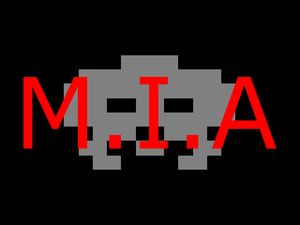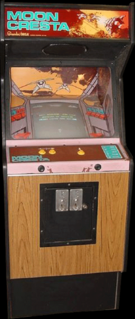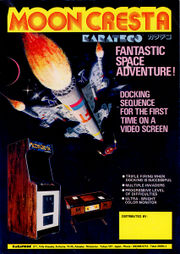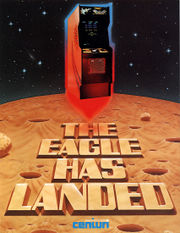Lost In Translation/Moon Cresta
| Moon Cresta | |
|---|---|
| Manufacturer | Nichibutsu |
| Released | 1980 |
| Control Method |
2-way Joystick 1 Button(s) |
| Main CPU | Z80 (@ 3.072 MHz) |
| Sound CPU | Mono Discrete |
| Video Details |
Raster (Vertical) 256 x 224 pixels 60.61 Hz 98 Palette colours |
| Screens | 1 |
| ROM Info | 13 ROMs 24,608 bytes (24.03 KiB) |
| MAME ID | mooncrst · eagle · eagle2 · eagle3 · fantazia · mooncrgx · mooncrs2 · mooncrs3 · mooncrsa · mooncrsb · mooncrsg · mooncrsu · smooncrs · spctbird |
About The Game
Moon Cresta is an arcade video game shoot-em-up in which players may compete for highest score against the game computer. Each time a player is hit by an alien, the game switches to his opponent's sequence.
The object is to destroy as many of the descending aliens as possible. To accomplish this the player is given a three stage multi-fire Warship. He begins with the first stage, firing a single laser at the enemy. If he is successful in eliminating the first 4 sets of aliens, he is given an opportunity to dock his first stage onto the second within a specific time limit (the sooner he unites the stages, the higher is his awarded score).
Once docked, the stages combine their firing power, so the first (1 laser) adds to the second (2 lasers) giving the player a total of 3 usable lasers as the game continues.
The player then must face 2 more sets of aliens and a shower of meteors, after which he has a chance to dock again, this time uniting with the third stage for a combined fire power of five lasers. If he is able to defeat the last two sets of aliens intact, the entire sequence begins again. The game continues with increasing difficulty until the entire warship is destroyed. When the warship is hit the player continues with whatever stages remain. If his score reaches 30,000 he is awarded a free game and his score continues to accumulate.
Trivia
Released in July 1980.
Also released as "Moon Cresta [Cocktail Table model]".
Licensed to Gremlin (September 1980) as "Moon Cresta (Gremlin)".
This game is known in US as "Eagle" (Licensed to Centuri for manufacture 10/1980).
Bill Awalin holds the official record for this game with 152,100 points.
2 bootlegs of this game are known as "Fantazia" and "Moon War".
A hacked version is known as "Super Moon Cresta".
Scoring
Scoring in this game is relatively simple. Each alien (except meteors and arrows) come in two different colors for each screen.
| Target | Points |
|---|---|
| Eyes (Break in half) | 50 |
| Eyes (Destroy other half) | 100 |
| Flies | 30 |
| Birds | 60 |
| Fireballs | 200 |
| Arrow Ships | 100 |
Docking is a big way to increase your score. You get the time remaining from 30 seconds multiplied by 100 for your docking bonus.
Tips and tricks
- When you start the game, all three stages of your ship will come from the bottom of the screen. After going halfway up, the ship on top separates from the other 2 and it settles onto the bottom of the screen ready for battle.
- Remember, you can only keep one set of shots in the 'air' at one time. This means you need to plan your shots out so you don't end up with a lot of misses when the aliens decided to come after your ship.
- In the later screens, the aliens start moving much quicker and you have to be on your toes to keep up with them and avoid being taken out.
- Although the aliens do not fire, they still can cause a lot of hate and discontent by their wild maneuvering. There is no real safe place on the screen from the aliens since they go into the lower corners of the screen, reappear from the bottom after they have apparently 'left' the screen, or just appear right above your ship.
- In the earlier waves, you have to split apart 2 eyes before the rest automatically split and come after your ship. In the later screens, the eyes automatically split upon entering the screen. That means eight instead of four aliens you have to deal with.
- If you manage to dock all three ships together, you will have a lot of firepower (5 shots at once) to send out. Here are some ways, unfortunately, you can lose ships and what ships are lost :
- Besides the aliens, docking is the second way people lose a lot of ships. The only ship destroyed is the ship attempting to dock.
- If an alien hits any part of your ships (if all stages are joined), only the stage hit is lost. This can create an amusing circumstance if you lose stage II and you only have stages I and III to fight with.
- Don't worry if you lose Stage I early in the game. One has to be very skilled to fight four screens with Stage I. Stage II is the best stage to fight with. It is a small target plus it has enough firepower to defend itself. Stage III on the other hand, is just a lumbering junkyard. The lasers are too spread out to do much good plus there is a very wide-open area in the middle for aliens to hit.
- The bird stages present the most challenge of the aliens. They appear and disappear at will. Sometimes they will appear right next to your ship so on these stages, be extra alert. If you see one disappear and don't hear the familiar bird chirp of it reappearing, assume it is on the screen somewhere still.
- The best place to 'hide' during the fireball stage is in the lower right corner. The fireballs will not hit your ship in this corner. You can do hit and runs by moving your ship out, shooting at a fireball, then going back to the corner again.
- During the arrow screen, the aliens will hover around the top, then turn into arrows and attempt to ram your ship. In the later screens, they won't even hover but just try to ram your ship.
- Your goal is to make it to 30,000 points so you can have a fresh ship waiting in case you lose all the stages of your present ship.
- Docking isn't that hard to do. After finishing off a wave just before the docking stage, try to center your ship on the screen. That way, all you have to do is move that ship left or right to successfully dock. You want to avoid using the thrusters unless your ship is in extreme peril. The docking bonus can be the most amount of points you score in the game. If you happen to miss a dock, then you will continue the next set of screens with the ship that failed to dock.
Series
- Moon Cresta [Upright model] (1980)
- Moon Cresta [Cocktail Table model] (1980)
- Terra Cresta (1985)
- Dangar - Ufo Robo (1986)
- Terra Force (1987)
- Terra Cresta II (1992, NEC PC Engine)
Staff
- Designed & Programmed By
- Shigeki Fujiwara
Cabinet and Artwork
Ports
- Consoles
- Nintendo Super Famicom (1995, "Nichibutsu Arcade Classics")
- Sony PlayStation 2 ("Oretachi Geasen Zoku Sono 5 - Moon Cresta")
- Computers
- Microtan 65 (1985)
- Sinclair ZX Spectrum (1985 - Incentive Software)
- Commodore C64 (1985 - Incentive Software)
- BBC B (1985, "Moon Cresta" - Incentive Software)
- Amstrad CPC (1986 - Incentive Software)
- Sharp X68000 (Year unknown)
- Commodore C64 (1992, "Classic Arcadia 3")
- Sinclair ZX Spectrum (1992, "Classic Arcadia 3")
Soundtrack Releases
| Album Name | Catalogue No. | Released | Publisher | Comments |
|---|---|---|---|---|
| GAME SOUND NICHIBUTSU -G.S.M. Nichibutsu 1- | D28B-0004[1] | 1988-09-21 | Pony Canyon, Inc. | CD version. |
| GAME SOUND NICHIBUTSU -G.S.M. Nichibutsu 1- | 25P5-0004[2] | 1988-09-21 | Pony Canyon, Inc. | Cassette version. |
| GAME SOUND NICHIBUTSU -G.S.M. Nichibutsu 1- | C22B-0004[3] | 1988-09-21 | Pony Canyon, Inc. | Vinyl version. |
| Arcade Ambiance 1981 | N/A[4] | 2002-01-01 | Andy Hofle | Digital download only. |
| Oretachi Game Center: Moon Cresta | N/A[5] | 2005-07-21 | Hamster | CD version. |
External Links
- Sinclair ZX Spectrum version of Moon Cresta at the World of Spectrum
References
- ↑ GAME SOUND NICHIBUTSU -G.S.M. Nichibutsu 1- (CD) at the VGMdb
- ↑ GAME SOUND NICHIBUTSU -G.S.M. Nichibutsu 1- (Cassette) at the VGMdb
- ↑ GAME SOUND NICHIBUTSU -G.S.M. Nichibutsu 1- (Vinyl) at the VGMdb
- ↑ Arcade Ambiance 1981 (Digital Download) at the VGMdb
- ↑ Oretachi Game Center: Moon Cresta (CD) at the VGMdb











